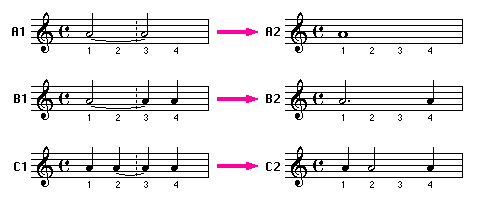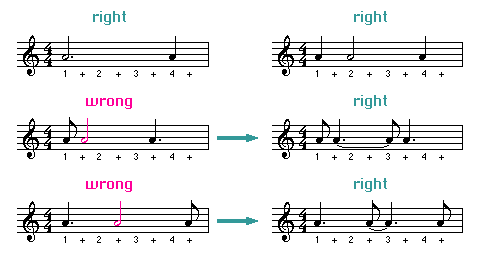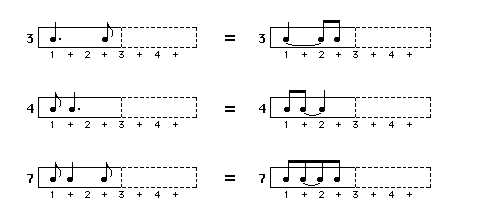(Down - Top)
RC 8.1 - Ties and Slurs
A tie is a curved line connecting two or more notes of the same pitch.
The tie combines both notes into one, its length being the combined total of the two.
In example A below the tied notes form a continuous sound of 1.5 beat.

A slur is a curved line connecting two, or covering more than two, notes of different pitches, as in example B.
The notes under the slur are played legato (smoothly). Wind instruments only tongue the first note of the slurred group.
A tie can only connect two notes together.
If more notes need to be tied together individual ties are used from one note to the next as shown below.
The three notes tied together shown below form a continuous sound of 3.5 beats.

Many notes can be covered just under one slur.
When within a group of slurred notes two notes of the same pitch occur next to each other (as notes 6 and 7 below), the second note is articulated (tongued on wind instruments) very lightly.

(Down - Up - Top)
RC 8.2 - Long Notes
So far we have not yet considered notes of more then 2 beats duration. Obviously they do not fit in any of the 2-beat rhythm segments dealt with so far.
To form long notes we combine two rhythm segments and then tie two adjacent shorter notes together.
- In Example A below, two minims tied together form one semibreve.
- In Example B one minim and one crotchet tied together form one dotted minim.
- In Example C two crotchets tied together form one minim on beats 2 and 3, across the centre of the bar.

To make reading music as easy as possible music notation is very visual oriented.
In general (as explained in Lesson 3) individual notes with black note heads do not span across the middle point (downbeat 3) of the bar.
Notes with white note heads may (and dotted minims and semibreves of course must) span across the middle point of the bar, but only when they start on a downbeat.

(Down - Up - Top)
RC 8.3 - Ties within one rhythm Segment
Ties within one individual 2-beat rhythm segment are generally used to show the beats more clearly.
Four of the basic 2-beat Rhythm Segments introduced in Lesson 3 contain notes which span across a beat.
The minim of Rhythm Segment 1 is quite straight forward, but rhythm segments 3 and 4 are quite commonly written as 3a and 4a below. This places a note on each downbeat which in turn makes for easier reading.
(Press on each bar to hear its Audio. Audios are in Swing style)

Rhythm segment 7 is sometimes written as 7a, but not all that often.
Rhythm Segments with rests, like for example 4b below can also be written with a tie.
